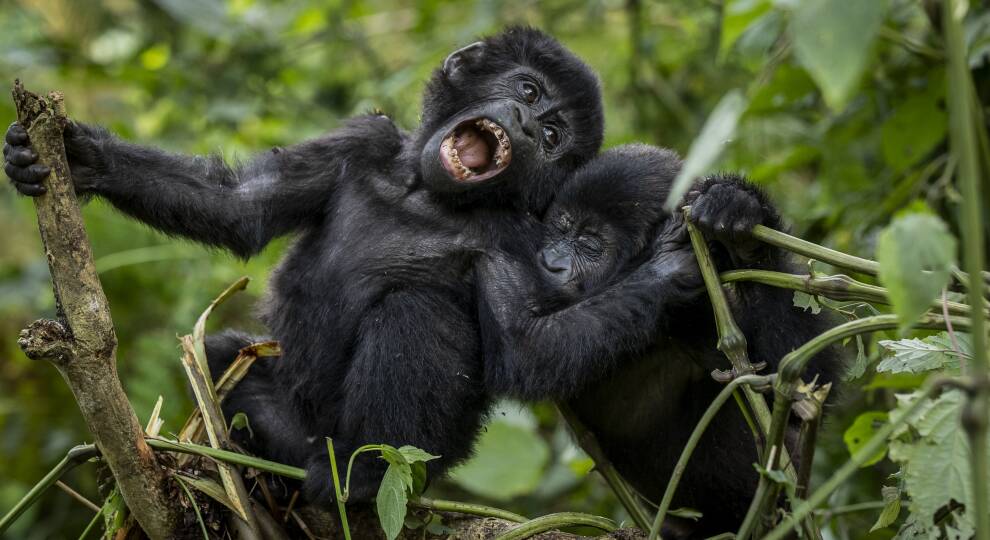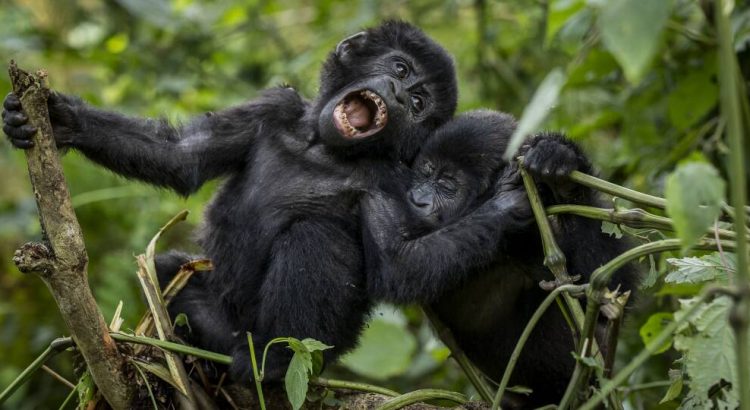
SOURCE: GBH
Countless natural disasters made worse from climate change and the degradation of our natural world feel like a steady drumbeat in the news. It’s hard not to feel discouraged, especially when we hear about the enormous amount of species that have gone extinct due to climate change and human activity. But there is hope.
This week’s edition of the Joy Beat celebrates the hard work and dedication of a world-class conservationist and wildlife veterinarian: Dr. Gladys Kalema-Zikusoka. She’s the founder and CEO of the grassroots non-governmental organization Conservation Through Public Health, and her new memoir dives into her career caring for Uganda’s mountain gorillas. She joined GBH’s All Things Considered host Arun Rath.
Arun Rath: First off, tell us about how you first got involved in conservation efforts in Uganda. I believe you started quite young, right?
Dr. Gladys Kalema-Zikusoka: Yes. I first got involved in conservation efforts when I revived a wildlife club at my high school in Uganda. I was very excited to go to the national parks. But when I saw that there was very little wildlife because it had been culled during the President Idi Amin era, I thought that I should become a veterinarian who works with wildlife.
I’d grown up with so many pets at home, and I really wanted to be a vet by the age of two. But by the age of 18, I felt like I wanted to be a vet that works with wildlife. Then, I got an opportunity to work with captive chimpanzees, and then I also got to work with chimpanzees in the wild and, finally, with mountain gorillas in the national park, one year after gorilla tourism had just begun. And I became Uganda’s first wildlife vet.
Rath: Tell us a bit more about your first encounter with gorillas and how you came to become enamored with these animals.
Kalema-Zikusoka: My first encounter with gorillas was really exciting. First of all, it took me a week before I could see them because I developed a nasty cold. But once I got better, we went to visit them, and that day we only saw one gorilla. We could be within five meters of distance with him.
I looked into his eyes, and it was a really deep connection. They’re very intelligent. I felt that they were so vulnerable, and we need to do something to protect them. At that time, there were so few left in the world, and that made me feel like I wanted to be a full-time wildlife veterinarian because I felt we needed to do something to prevent them from going extinct.
Rath: It’s interesting because Uganda has such fantastic natural beauty and wildlife, but you just reminded me in this conversation that we’re talking about the post-Idi Amin period when the wildlife had not been taken care of. Talk about what the situation was and how the country had recovered in terms of the natural landscape.
Kalema-Zikusoka: During the Idi Amin era, the president himself was hunting elephants in the national parks. The national parks were supposed to be a safe haven for wildlife. The wardens tried to stop it, but eventually, they couldn’t anymore, so elephant poaching went up. Later, when the army overthrew Idi Amin, some of the soldiers also ate meat from the forests and the national parks, so a lot of numbers went down, and the elephants and rhinos were pushed to extinction.
Then, in 1987, mountain gorillas were discovered. They thought the only population was in the Virunga Mountains, but suddenly, in ‘87, after doing genetic studies, they found out that there is a second population. Having seen how Rwanda was benefiting from mountain gorilla tourism, Uganda started to habituate them, and a few years later, tourism began.
That completely transformed the situation in Uganda because gorilla tourism is now raising so much revenue that some of it was going to support the other national parks that don’t get enough tourists because they don’t have enough wildlife or it’s not easy to get to the wildlife. It really transformed the landscape.
When I first started working with gorillas, there were only two groups habituated for tourism. Now, there’s 22 groups. So at any one time, you can have almost 180 people in the park, whereas before, there were only 12 people.
It’s transformed people’s lives. Most people employed by the park are from the local communities, and we are also engaging them in our nonprofit, so it’s really transforming the whole area.
“You can’t protect the gorillas and their habitat without improving the health and well-being of the people who they share their fragile habitats with.”
Rath: My next question was going to be about how your NGO, Conservation Through Public Health, and how public health ties into wildlife conservation. But I feel like you gave us a bit of a preview on that. Talk about that some more.
Kalema-Zikusoka: Actually, one of the very first cases I had to deal with as Uganda’s first wildlife vet working for the national parks, which later became the Uganda Wildlife Authority, was a skin disease outbreak on the then-critically endangered mountain gorillas. They called me and said the gorillas are developing white, scaly skin. So I wondered what it could be, and a human doctor friend of mine told me the most common skin disease in people is scabies.
So I went with a drug called ivermectin, which is very good for any parasites. When we got there, it turned out to be scabies. The baby gorilla had sadly died, but the others recovered with treatment. Their hair started to grow back and stop scratching.
We started asking ourselves, “Where could this have come from?” The two groups habituated for tourism was spending a lot of time outside the national park because their habitat had been cut down, and they were always going out to look for banana plants. It had been cut down because of the high human population density. We found that those people were very poor and they had very little health care. When we met with them, they said they wanted to improve the situation because they don’t want to make the gorillas sick, and they wanted to be more healthy and have better well-being.
This made me realize you can’t protect the gorillas and their habitat without improving the health and well-being of the people who they share their fragile habitats with. A few years later, we founded Conservation Through Public Health.
I did research looking at tuberculosis in people, wildlife and livestock, and I understood how the public health system works in Uganda. All of this information helped us to found Conversation Through Public Health.
Rath: As I mentioned at the top, it seems like most of what we hear about wildlife and conservation is typically bad or terrible news — almost panicking. It’s nice to be able to talk to you about hopeful stories like this, about how wildlife can rebound. Can I ask you for any additional hope? Are there ways in which what you’ve accomplished in Uganda could apply in other places? Are there other ways that we could do what you’ve been able to pull off there?
Kalema-Zikusoka: Actually, we have found that as the health of the community is improving, people are not poaching as much. We show them that we care about them and their health, which is a basic human right, and not only about the wildlife and the forests. We’re very excited about that.
Tourism has also helped. Communities are much happier. I’ll say that there are other countries in Africa where the numbers of gorilla species are going down, but the mountain gorilla population has almost doubled over the past 25 years and is still growing, which is exciting.
In other countries in Africa, where there are no community benefits, there isn’t much support for communities — there’s still a lot of hunting. This particular model could really work, and it could also work in other areas with other wildlife.
I’ve actually been speaking at the Wilson Center today, and the very question they asked was like this. They said, “We would love to scale up our approach to other parts of the world.”
